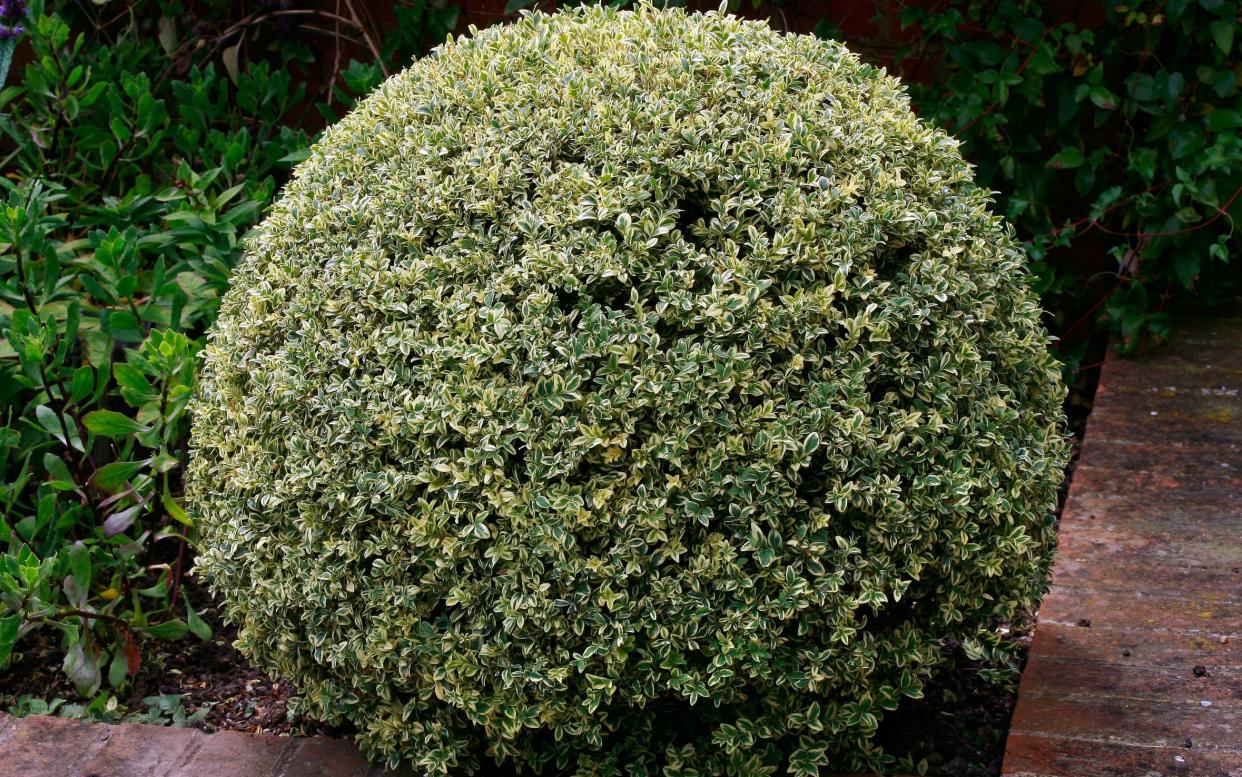How to spot box blight, and what to do about it

The relentless rain of the last few months is probably going to have a sting in its tail, because it’s going to encourage lots of fungal spores. One of the most feared diseases among gardeners is box blight, which reduces a healthy box to an unsightly, leafless skeleton. It’s caused by two closely related pathogens: Calonectria pseudonaviculata and C. henricotiae (syn. Cylindrocladium buxicola). White spore masses can be seen on the undersides of infected leaves in wet conditions, and you’ll also see black streaking on the dead stems.
The disease was first identified in 1994 at a long-gone Hampshire nursery that specialised in Buxus sempervirens, or box. Some larger topiarised plants had been grown in moist, warm tunnels in Italy, conditions that positively encouraged fungal growth. It spread quickly once it arrived here, so lots of open gardens had bare box parterres by 2000. Many a visitor to these gardens would have unwittingly carried the disease back to their own, either on their clothing or shoes, as they brushed past. The moral is, don’t walk through infected box; go around it.
Jobbing gardeners, using their cutting equipment in several different gardens, would also have transferred this fungus, again unwittingly. I strongly advise you to invest in your own equipment to use exclusively on your own box. If you want to do it by hand, and only have a few box plants, invest in some Jakoti hand shears: they’re excellent. If you need a machine, I recommend the light, hand-held Stihl HSA26. It’s turned three days of blister-making hand-clipping into a few hours in my garden (and I’m not lending it out).
Every time you clip, place some horticultural fleece on the ground so that you can pick up all the cuttings easily. Don’t leave them to fester on the ground. I find that tidying often takes longer than clipping. Cutting it back year after year in high summer, a tradition adopted by large country estates in the days when everyone went off for Derby Day at the beginning of June, scorches the new growth and stresses the plant. In Holland, gardeners have started to cut their box in winter, when temperatures are cooler, in order to prevent the fungus from spreading. It’s a thought.
Shape matters
Flat-topped low hedges in parterres don’t shed rainfall as efficiently as topiarised roundels, cones, ovals and pyramids, because gravity and air flow help to dry off the raindrops. Drier foliage is less likely to suffer, especially if the air can circulate, so try to give your box plants an airy position if possible. If you decide to containerise these shallow-rooted evergreens, stand them on pot feet, to improve drainage. Keep them well-fed and watered in the growing season, so the foliage stays lush and green. Left to its own devices, box will turn a metallic olive-green.

Choose resistant varieties
You’re likely to get more problems in the western half of Britain, because it’s wetter. Sir Roy Strong, who developed The Laskett garden in Herefordshire from 1974 onwards, was beyond upset when he lost his box framework. The present head gardener, James Madge, told me that he will have to remove more box in the future. However, he’s found that variegated box, Buxus sempervirens ‘Elegantissima’, resists box blight. I agree. I have never seen ‘Elegantissima’ looking anything but healthy.
Waterperry Gardens, near Wheatley in Oxfordshire, came to the same conclusion after garden manager Rob Jacobs noticed that this lightly variegated form had escaped box blight even when close to infected box plants. ‘Elegantissima’ has green foliage with an irregular cream-white edging to the small leaves, so you don’t get the same rich green colour, but it’s a good replacement.
Box blight is no respecter of wealth or title and the King (then the Prince of Wales) had to remove all his box from the productive Walled Garden at Highgrove in 2010. He replaced it with Teucrium x lucidrys, a cross between wall germander Teucrium chamaedrys and sage-leaved germander . This is more upright than wall germander, with greener foliage, and it’s trimmed after flowering so that it stays compact throughout winter. It looks well within the vegetable garden, but doesn’t have the same crisp profile needed for a smart parterre.
The question is, do you need a smart parterre? At Broughton Grange near Banbury, the parterre has been given the freedom to form contours. Those rounded hummocks throw off the rain far more efficiently than flat-topped hedges and look more modern. The designer Arne Maynard creates mounds of box that echo the landscape beyond, borrowing the landscape of the hilly Malverns or Chilterns, for instance.
Alternative plants are few and far between, however, because box is unique. It was thought that the slow-growing Japanese holly, Ilex crenata, would do the same job, but this has proved a disappointment for many. It has failed to thrive because Asian plants like a warm, wet summer followed by a drier, colder winter. Our winters are too warm and wet and summers are often too dry.
What to do if you have box blight
If you spot the early symptoms, prune it out as soon as you see it and destroy the material.
Once you have snipped out the infected parts, tidy up all the fallen leaves, because the spores can survive for six years. After removing the infected areas, give your box a seaweed feed, because this toughens up the foliage.
A gardener I know, Stephanie Richards of Eastleach House, solved her problem accidentally. She had to remove a whole section of box hedge in her walled garden some years ago. The top growth was cut off and burnt and then the area was tidied meticulously. The stumps were left in for removal in the winter, but the job failed to get done, as so often happens. In spring, Stephanie’s box hedge began to grow back and showed no sign of the disease, so it was left alone. No fungicides were applied. This supports the scientific information that box blight doesn’t get into the root system.
Another head gardener close to me spotted patches of box blight for the first time. All the affected areas were snipped out and burnt and seaweed plant food, which not only feeds but toughens up the foliage, was watered on to all the box from thence onwards. The box flying saucer shapes were gappy, but they stayed healthy and the new foliage soon grew back. Early physical intervention, i.e. nipping it in the bud and cutting it out, does work. No fungicides were used.
Another box threat to note
Box tree caterpillar, Cydalima perspectalis, is also moving northwards after invading London and the south of England since 2007/2008. The National Trust’s Ham House near Richmond, which is organically run, saw its caterpillars cleared by a flock of 10 hungry jackdaws, which proves that birds find them palatable. The jackdaws cleared them in spring and again in August, and blue tits and starlings also devoured them. This is good news, for Ham House – it has 1,000 yards of box in its garden. I’m reliably informed that the box recovers quickly, but I’ve yet to find out.


